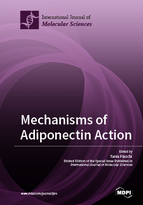Mechanisms of Adiponectin Action
A special issue of International Journal of Molecular Sciences (ISSN 1422-0067). This special issue belongs to the section "Bioactives and Nutraceuticals".
Deadline for manuscript submissions: closed (28 February 2019) | Viewed by 89177
Special Issue Editor
Interests: skeletal muscle; cancer cachexia
Special Issues, Collections and Topics in MDPI journals
Special Issue Information
Dear Colleagues,
Adiponectin is an adipokine circulating in the blood stream and is locally produced by various tissues. The main effect of adiponectin concerns metabolism regulation since it controls glucose and triglyceride homeostasis, thus helping insulin action in healthy tissues, such as liver and skeletal muscle. Obesity and metabolic syndrome leads to adiponectin decrease, thus predisposing diabetes onset. However, growing evidence suggests a more pleiotropic role of the hormone in different tissues. Adiponectin affects autophagy, cell differentiation and stem cell behavior, while hypoadiponectinemia has been correlated with several types of cancers. The Special Issue, “Mechanisms of Adiponectin Action” of the International Journal of Molecular Sciences will include a selection of research papers and reviews about various aspects of the molecular and cellular biology of adiponectin. In addition, studies on molecules able to modulate adiponectin signaling, and their possible use in the treatment of pathologies in which adiponectin is involved, will also be considered.
Dr. Tania Fiaschi
Guest Editor
Manuscript Submission Information
Manuscripts should be submitted online at www.mdpi.com by registering and logging in to this website. Once you are registered, click here to go to the submission form. Manuscripts can be submitted until the deadline. All submissions that pass pre-check are peer-reviewed. Accepted papers will be published continuously in the journal (as soon as accepted) and will be listed together on the special issue website. Research articles, review articles as well as short communications are invited. For planned papers, a title and short abstract (about 100 words) can be sent to the Editorial Office for announcement on this website.
Submitted manuscripts should not have been published previously, nor be under consideration for publication elsewhere (except conference proceedings papers). All manuscripts are thoroughly refereed through a single-blind peer-review process. A guide for authors and other relevant information for submission of manuscripts is available on the Instructions for Authors page. International Journal of Molecular Sciences is an international peer-reviewed open access semimonthly journal published by MDPI.
Please visit the Instructions for Authors page before submitting a manuscript. There is an Article Processing Charge (APC) for publication in this open access journal. For details about the APC please see here. Submitted papers should be well formatted and use good English. Authors may use MDPI's English editing service prior to publication or during author revisions.
Keywords
- Adiponectin
- Metabolism
- Cell signaling
- Differentiation
- Stem cells
- Cancer







